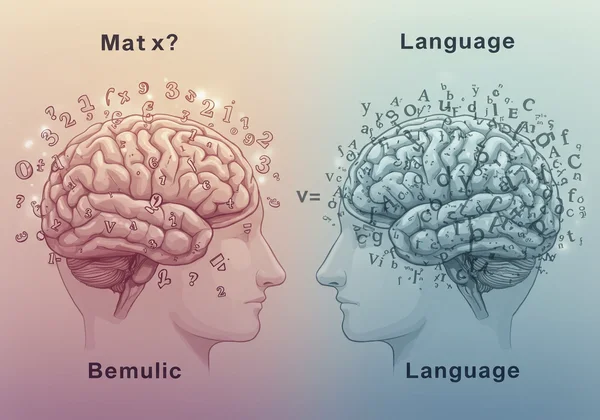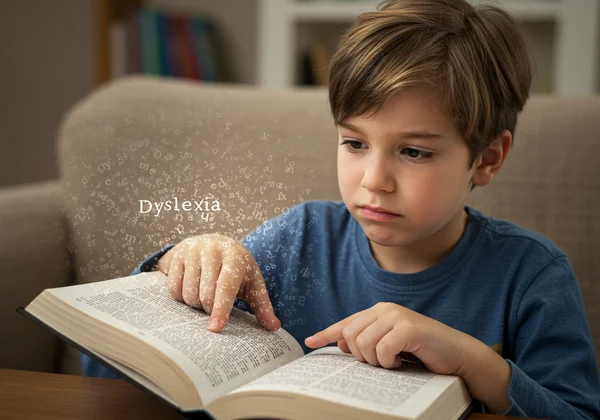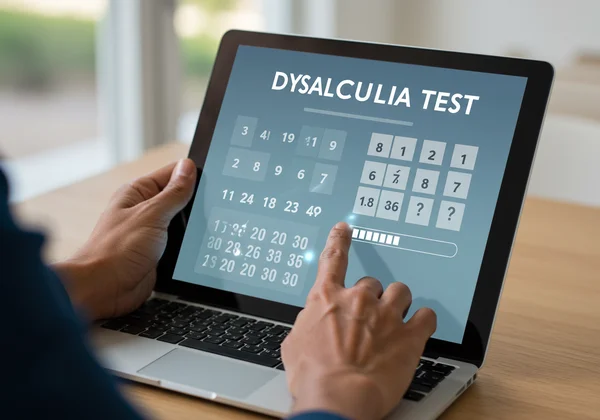Dyscalculia vs. Dyslexia: Free Dyscalculia Test & Screening Insights
Are you or your child struggling with learning, but you're not sure if the root cause is related to math, reading, or something else entirely? Many people confuse dyscalculia and dyslexia. While both are specific learning differences, they impact the brain and daily life in fundamentally different ways. This guide will clarify the key distinctions between dyscalculia vs. dyslexia, helping you understand the unique challenges of each and guiding you toward the right kind of support. Are you trying to pinpoint the source of these learning struggles?
Grasping these conditions is the key to empowerment. For parents, adults, and educators, this understanding transforms confusion into clarity. By identifying the specific nature of a learning challenge, we can unlock tailored strategies that truly make a difference. Let's explore the distinct worlds of numbers and words to see where the difficulties may lie and discover how a free dyscalculia test can offer valuable insights.

What is Dyscalculia? Decoding Math Learning Difficulties
Dyscalculia is a specific and persistent difficulty in understanding numbers and mathematical concepts. It's often described as "math dyslexia," but this comparison, while helpful, only scratches the surface. At its core, dyscalculia stems from a weakness in the brain's innate "number sense," which is the intuitive ability to grasp, compare, and manipulate quantities. This isn't about a lack of effort or intelligence; it's a neurodevelopmental difference that makes interacting with numbers feel like trying to speak a foreign language.
Individuals with dyscalculia may struggle to connect a number symbol (like "5") to the quantity it represents (five items). This fundamental challenge can cascade into difficulties with everything from basic arithmetic to more complex mathematical reasoning. It's a persistent challenge that affects academic performance, daily life tasks like budgeting, and even time management.
Common Signs of Dyscalculia in Children and Teens
For concerned parents and educators, recognizing the signs early is crucial for providing support. While every child develops at their own pace, a consistent pattern of these learning differences may warrant a closer look.
In young children, signs can include:
- Difficulty learning to count and linking numbers to objects.
- Trouble recognizing number patterns, like "2, 4, 6."
- Reliance on finger counting long after peers have stopped.
- Struggles with remembering basic math facts, such as 2+3=5.
As children enter their teens, the challenges evolve:
- Difficulty understanding place value, fractions, or negative numbers.
- Significant trouble with word problems and multi-step calculations.
- Anxiety when asked to perform mental math.
- Struggles with telling time on an analog clock or estimating measurements.
Recognizing Dyscalculia in Adults: More Than Just "Bad at Math"
Many adults have navigated their lives simply believing they are "bad at math" without realizing there might be an underlying reason. This can lead to significant math anxiety and avoidance of number-related tasks in their careers and personal lives.
Common signs in adults include:
- Intense difficulty with budgeting, calculating tips, or balancing a checkbook.
- Trouble remembering numerical information like phone numbers or PINs.
- Inability to easily grasp charts, graphs, or data presented visually.
- A tendency to get lost easily or struggle with judging speed and distance.
If these challenges resonate with you, it may be more than just a dislike for math. Understanding the root cause is the first step toward finding effective strategies. A free dyscalculia test can be an excellent starting point on this journey of self-discovery.

What is Dyslexia? Understanding Reading & Language Challenges
Dyslexia is another common learning difference, but its domain is language, not numbers. It is characterized by difficulties with accurate and/or fluent word recognition and by poor spelling and decoding abilities. These challenges typically result from a deficit in the phonological component of language—the ability to recognize and manipulate the sounds in spoken words.
Essentially, individuals with dyslexia have trouble connecting letters on a page to the sounds they represent. This makes the fundamental process of reading slow, laborious, and frustrating. It is crucial to understand that dyslexia is not a sign of low intelligence. In fact, many people with dyslexia are highly creative and excel in areas like problem-solving, art, and entrepreneurship.
Core Symptoms of Dyslexia: Reading, Writing, and Spelling
The most apparent symptoms of dyslexia revolve around literacy and reading challenges. A child or adult with dyslexia might:
- Read slowly and with great effort.
- Have trouble sounding out unfamiliar words.
- Confuse letters that look similar (like 'b' and 'd') or sound similar.
- Struggle significantly with spelling, often making inconsistent errors.
- Find it difficult to express their ideas clearly in writing, even if they can explain them verbally.
Broader Impacts of Dyslexia Beyond Literacy
The effects of dyslexia can extend beyond just reading and writing. Because language processing is so fundamental, individuals may also experience difficulties with:
- Remembering sequences, like the days of the week or months of the year.
- Following multi-step directions.
- Learning a foreign language.
- Organizing their thoughts for both spoken and written tasks.
These broader impacts highlight that dyslexia is a comprehensive language processing difference, not just a simple reading problem.

Dyscalculia and Dyslexia: A Side-by-Side Comparison
While both conditions can make school and daily life challenging, understanding their distinct profiles is key to providing effective support. Mistaking one for the other can lead to frustrating and ineffective interventions. Exploring the differences in dyslexia and dyscalculia can provide much-needed clarity.
Here's a breakdown of the core distinctions:
| Feature | Dyscalculia (Math Learning Difference) | Dyslexia (Reading Learning Difference) |
|---|---|---|
| Primary Area Affected | Number sense, mathematical reasoning | Phonological processing, word decoding |
| Core Difficulty | Grasping quantity, symbols, and concepts | Connecting letters to sounds |
| Common Symptoms | Trouble with counting, calculation, telling time | Slow reading, poor spelling, word confusion |
| Brain Regions | Intraparietal sulcus (related to number processing) | Left hemisphere language networks |
Distinct Cognitive Roots: Number Sense vs. Phonological Processing
The cognitive roots of these two conditions are entirely different. Dyscalculia is linked to the brain's parietal lobe, specifically the areas that manage our innate sense of quantity. Dyslexia, on the other hand, is primarily associated with the brain's language centers, which process sounds and link them to written symbols. This neurological distinction is why someone can be a brilliant reader but struggle with basic math, or vice versa.
Rates of Co-Occurrence: Can You Have Both?
A common and important question is whether an individual can have both dyscalculia and dyslexia. The answer is yes. Research suggests a significant rate of co-occurrence, with some studies estimating that up to 40% of individuals with one condition may show signs of the other. When they occur together, it can create a complex web of learning challenges that require a comprehensive and integrated support plan. If you suspect multiple challenges are present, getting a clear picture is even more critical.
Tailored Support Strategies for Each Learning Difference
Because their origins are different, effective support strategies must also be different. For dyscalculia, interventions focus on building number sense from the ground up using multi-sensory techniques, visual aids, and real-world applications. For dyslexia, the gold standard is structured, systematic literacy instruction that explicitly teaches the connections between letters and sounds. Applying a reading strategy to a math problem simply won't work. Identifying the primary challenge is the first step toward finding a solution that fits. Take our test to begin exploring.
Your Next Steps Towards Clarity and Support
After learning about these differences, you might be wondering what to do next. If you or someone you care about shows signs of math-related struggles, taking a reliable dyscalculia test is an essential step towards gaining insight. This is where our platform comes in, offering a clear and accessible path forward.
Why a Free Online Screening is a Powerful Starting Point
A formal diagnosis can be a long and expensive process. A free online screening provides an immediate, low-pressure way to gather information and assess the likelihood of dyscalculia. It serves as a valuable preliminary tool, helping you decide if further professional assessment is needed. Our screening, developed by educational psychologists and math experts, gives you a look at potential areas of difficulty, empowering you with knowledge right from the start.

Beyond the Test: Personalized Insights for Your Journey
Our commitment to helping you doesn't end with a simple score. After completing the free test, you have the option to receive a comprehensive, AI-powered report. This report offers personalized insights that go far beyond a basic result. It provides a detailed cognitive profile, highlights potential strengths and challenges, and suggests tailored strategies and tools to support your unique learning journey. It's a roadmap designed to help you or your child navigate math challenges with confidence.
Distinguishing between dyscalculia and dyslexia is more than an academic exercise; it's a critical move toward providing the right support and fostering self-confidence. Understanding that these are distinct, brain-based learning differences helps replace self-doubt with self-awareness. Whether the challenge lies with numbers, words, or both, knowledge paves the way for tailored strategies and greater success.
If the signs of dyscalculia described here feel familiar, don't wait in uncertainty. Take the important step toward clarity today. Visit DyscalculiaTest.com to take our free, expert-designed screening and start your journey toward understanding and empowerment.
Frequently Asked Questions
What are the main signs of dyscalculia in children and adults?
In children, key signs include persistent trouble with counting, memorizing basic math facts, and telling time. In adults, it often appears as significant difficulty with daily tasks like budgeting, calculating tips, and high levels of anxiety around numbers.
How is dyscalculia different from just being "bad at math"?
While many people dislike math, dyscalculia is a specific neurological difference that impairs the ability to learn and process numerical information. It's not about a lack of effort or intelligence but a persistent and often severe challenge with foundational number sense that doesn't improve with typical instruction.
Is there a reliable online test for dyscalculia?
Yes, a quality online dyscalculia test can be a very reliable first step. While it is not a substitute for a formal clinical diagnosis, a high-quality screening designed by experts can accurately identify signs of dyscalculia. It can provide valuable insights and help you determine if further professional evaluation is necessary.